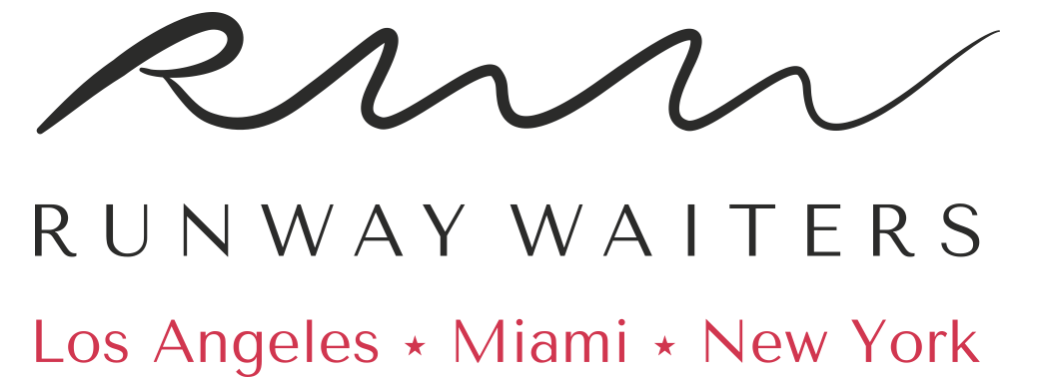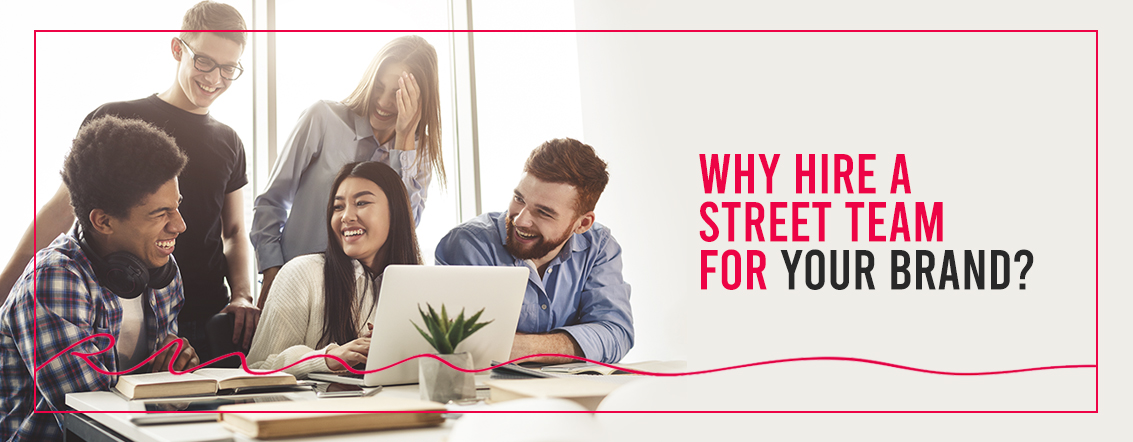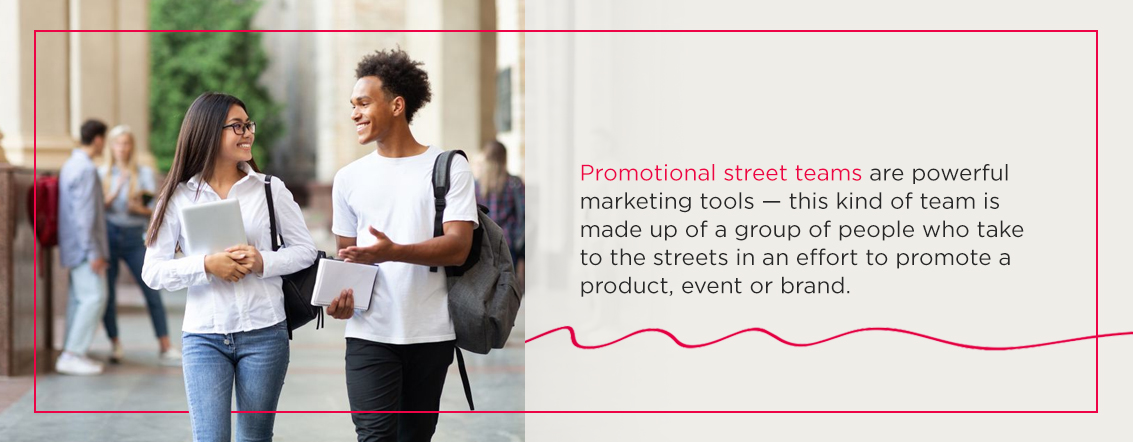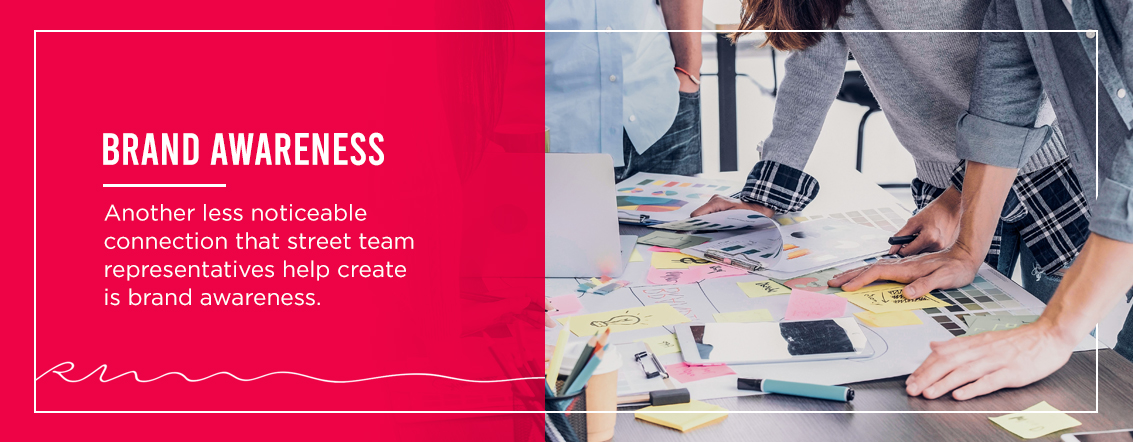If you’ve ever seen publicity stunts or groups of people in branded T-shirts handing out flyers, you’ve probably been witness to the work of a street team. These innovative groups of people power the marketing efforts of businesses of all types. Small and large businesses alike benefit from their work, which might include putting up posters, starting guerilla marketing campaigns, and handing out free items.
They get your brand in front of everyone who walks by in high-traffic areas and put a face to the business. Passersby see a smiling team member, have a quick conversation, and make a personal connection with them while learning about your product or service.
Paired with other promotional efforts, like advertisements and freebies, you can use street teams to reach a variety of marketing goals. Street teams can include a wide range of styles and tactics, so let’s dive into what they are and how street teams can help your brand.
What Is a Street Team?
Promotional street teams are powerful marketing tools — this kind of team is made up of a group of people who take to the streets in an effort to promote a product, event or brand. They lean on face-to-face interaction to get their point across and may use a wide variety of tactics to get the attention of people walking by. Some of these tactics include:
- Freebies
- Publicity stunts
- Handing out flyers and putting up posters
- Talking to passersby
Much of the success of street teams comes down to the charisma and enthusiasm of the street team representatives and the organization of the team. The team members must come off as passionate about the company they’re working for and be trained in the art of street team marketing, which varies greatly from other types of marketing. Street teams often need to focus more on the individuals of the team and their personal skills. They have to appear authentic, marketable to the company’s target audience and knowledgable about the product.
While street teams are common in grassroots campaigns for musicians and authors, they’re also effective for many types of business and events. Small businesses, large corporations, sports teams, product launches and events can all experience the benefits of street team advertising. What’s important is that the brand ambassadors represent the company and its culture and abide by the best approach to reach a target audience. They should be passionate about the work and invested in what they’re doing.
Marketing departments must think very strategically about street teams, considering aspects about their target audience such as behavior, interests, and habits, alongside basic demographics like age and gender. To find your target audience, ask yourself questions regarding:
- Face-to-face meetings: Consider whether your potential customers will benefit from face-to-face meetings or not.
- Promoted selling points: Are there aspects to the business or product that are better communicated in person than on digital channels?
- Niche markets: Can you find your audience in high concentrations at a specific event or location?
- Publicity: Do you think street marketing will help your company get more attention?
Making Connections
Part of the reason for a street team’s success lies in their ability to connect with others on a personal level. They should be able to develop relationships in a short amount of time that keep a customer coming back. Street teams might consist of influencers, too, or people big in the community of their industry. Groups canvassing for musicians, for instance, may have a lot of clout among music fans.
If they are popular and well-respected, others will take their endorsement more readily. They can also reach more people through their followers. These are often connections that marketing teams simply can’t create. And if you’re trying to implement street team promotions in NYC or Los Angeles, where life is busy and fast-paced, a quick but authentic human connection can go a long way.
Creating strong connections requires hard work on the part of the team and the organizers. The organizers need to set up the team in high-traffic areas where they are likely to meet the right people. They must consider things like where the audience is likely to respond, what will capture their attention and how they can find them at the right time. Audience targeting methods will come in handy here, as will strategic planning.
The team members must also be the whole package. They’ll need to be personable, outgoing and savvy, while meeting the targets set forth by the brand they’re working for. Their tasks include educating people on the product or company, generating leads, and getting people’s attention in a busy environment.
On top of all that, they must also have the right appearance to represent the brand. An energetic college-aged girl might have the image to sell backpacks to students her age, but not to sell wrinkle-removing makeup to middle-aged women. They’re probably more likely to listen to someone their age who understands the problem they’re dealing with and can speak to it. The right ambassador can develop a better connection than someone ill-suited to the task.
So, how exactly do these guerilla marketers make powerful connections in such a casual, fast-paced setting? Lead generation and brand awareness are significant parts of that.
Lead Generation
Lead generation hinges on the idea that the street team can capture their attention initially and follow up with it to get a more engaged customer. They might hold some kind of publicity stunt, hand out freebies on the street or tell them to sign up for emails, where they’ll get a coupon or special offer.
Once they’ve got their coupon, they are likely to stay on your email list, where you can send them a welcome message with more information about your product or company. After that, you can send email blasts about sales, newsletters or new releases. They’ll get more information from that, creating a great opportunity for conversions. Capitalizing on the fact that most people have a smartphone in their pocket, street team members can sign people up on their phones or have signs that tell guests who to text or email to sign up for more information.
Brand Awareness
Another less noticeable connection that street team representatives help create is brand awareness. Whether you deck out your team in branded clothing or simply hand out informational flyers, you’re putting your image in front of more people and associating it with a real person with a warm smile and a face to match to the company. Accompany these things with an activity or stunt, and they’ll also have a memorable event to pair it with. Giving out branded freebies can make them see your logo long after they’ve passed your team.
Keep in mind that 85 percent of small businesses get their customers through word of mouth — that’s why street teams can be so effective when they make an authentic connection with passersby. It may not be the same as getting a recommendation from their trusted friend, but it still helps them to associate your company with a person and image who endorses it.
How Street Teams Drive Foot Traffic
If your business involves a brick-and-mortar store or an event, like a concert or trade show, you may be looking to increase foot traffic, not necessarily leads or social media follows. Street team marketing campaigns can also address this goal. Many of the tactics that street teams use are great for traffic, such as sidewalk painting, where they’ll draw on the sidewalk and direct people to your door. They may also put up posters that offer coupon codes to people who go in or send people more directly toward your building.
Street teams work in high-traffic areas to contact as many people as possible. They’ll station themselves on popular blocks and near busy intersections — wherever they can to get flyers, freebies and information into more hands. But they can’t be just any hands. Street teams also capitalize on extensive audience targeting. Typically, they’ll zero in on their target audience and work in places where they are likely to find them.
A company selling protein powder, for example, might choose to stand on a city block that has three gyms nearby and sees traffic from fitness-minded people. Another popular example includes college campuses, where students are likely to be hanging around in between classes or walking to their next one.
When it comes to finding these target audiences, street teams or their marketers ask questions like:
- What do our customers like about our product or service, and how can we highlight that when selling to them?
- What kinds of things are they interested in?
- Where in town do they go regularly?
- What is their opinion of our brand?
- What problems do they have that our product or service can solve?
By answering these types of questions, you can target the people who are most likely to convert. If your goal is foot traffic, you can focus on the people most likely to walk into your store or business. Your team won’t waste time on people far outside of their market or those who won’t convert.
One way that a street team staff convinces people to step inside is by instilling FOMO, or the fear of missing out, in passersby. Whether they’re creating a scene via a publicity stunt or a social media wave by engaging people on the street, it makes people want to be a part of whatever’s going on. Even simply telling people about your product in a casual conversation can create FOMO. Seeing a large group of people supporting a product shows them that other people know something they don’t.
Hand Out Materials
If you’ve ever been to a trade show or a college campus event, you know how much people love free stuff. People will pay more attention to you if you reward them with something when you’re done. Think of it as payment for the amount of time you’re taking out of their day. Draw them in with promises of free stuff, and while they’re listening, convince them of why your product or service is worth buying. You can always give out the classic freebies, like hats, water bottles, stress balls, and T-shirts, but you could also get more creative. Try items that are more tailored to your business, such as:
- Event or concert tickets or a sign-up for a raffle to win them
- Free music downloads
- Product trials
- Sample sizes of products
- Samples of food or drink
When you give out free items like this, you give the customer a positive association with your brand and can keep your brand in front of them more often. For example, if you give out water bottles, your guests may see your logo every time they fill it up throughout the day.
Plus, people who see them carrying it will also be exposed to your brand. It’s an excellent way to reach people long after you interact with them and improve brand awareness. Working outside of conventions and trade shows is a great place for freebies. Attendees will see other people carrying them or will tell their colleagues about the cool items they get and could bring more people to you.
While it might not seem like it, handing out freebies can be an excellent way to both increase profits and improve your customers’ perceptions of you. Free items have interesting psychological effects on people’s buying habits and can mean profits for your business, along with increased brand awareness. When your street team hands out freebies, people can react in several ways, such as:
- They may feel obligated to spend more with you, feeling like the free item is a favor they should reciprocate — a strong connection with the team member can make this especially true.
- They might associate the item as being more valuable than it is, particularly if it’s connected to a higher-value item.
- They could talk about your item with more people. People tend to talk about items more if they’re given to them for free.
Another common item to hand out during street marketing is flyers. They may seem like something that many people will throw out, and that’s true, but many will also hang onto them, especially if you’re reaching the right audience. If they hang onto your flyer, they have a convenient display of your business or event information, making them more likely to show up.
If applicable, put your freebie, like a coupon code, free restaurant item, or download, on the flyers to increase the chances of someone holding onto it. The street team will need to keep the area clean, though, as you don’t want people seeing your flyers crumpled up and tossed to the curb like low-value items.
Book Your Next Event With Runway Waiters
Street teams depend entirely on the people running the show. Your street team’s brand ambassadors need to look the part, representing your brand to the fullest extent, while employing exceptional people skills to reach those walking by. Whether you want to increase brand recognition, drive foot traffic, or achieve some other marketing goal, street teams are an excellent way to get the word out.
Wondering how to build a street team? Runway Waiters has you covered. Our staff is made up of agency-signed fashion models who are personable, professional and friendly. You might see them at events like New York Fashion Week and Miami Swim Week, as well as in various major projects throughout the city. With a high-fashion look and the skills to back them up, they perform as brand ambassadors to deliver the message you want to convey.
To start developing a street team in New York, Los Angeles, Miami, and other major cities, reach out to us today.







